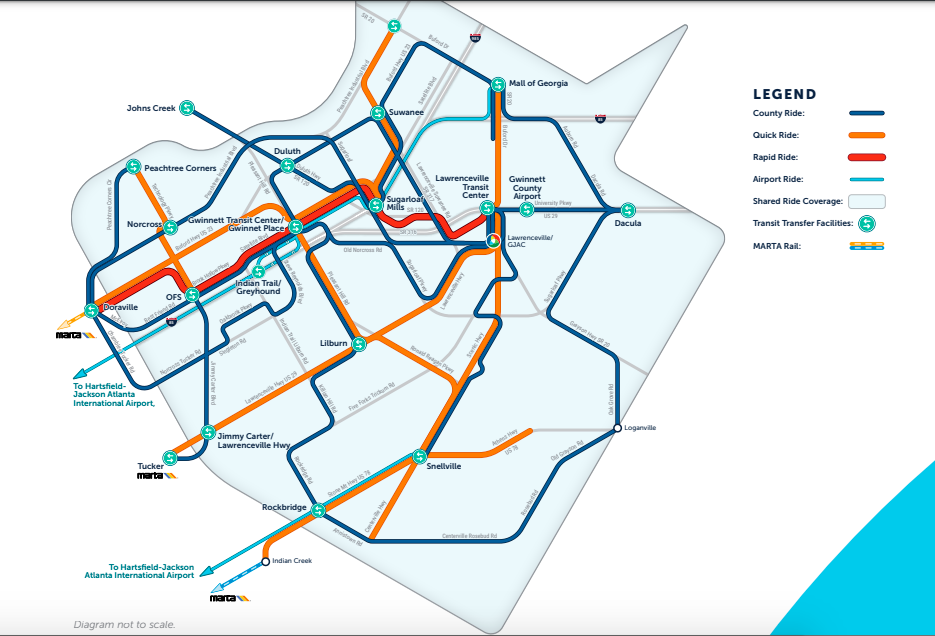Gwinnett’s next transit referendum vote is weeks away. Will it pass? Josh Green Tue, 09/24/2024 - 14:09 Today marks exactly six weeks until Americans will be asked to make a monumental, potentially historic decision: Will Gwinnett County see $17 billion worth of transit investment in its future, or not?
Another way of framing the question: For Georgia’s second most populous county—with a population that topped 1 million for the first time in history this year—could the third time for referendum votes in the past five years be a charm?
Back in June, the Gwinnett County Board of Commissioners voted 4-1 in favor of placing a SPLOST transit referendum on the Nov. 5 General Election ballot, which also includes the presidential election. Should Gwinnett voters approve the extra funding for transit—historically, and infamously if you ask Atlanta urbanists, they have not—the transit referendum would impose a 1 percent sales tax for up to 30 years.
According to county leadership, the estimated $17 billion culled from consumer spending in Gwinnett would fund up to 75 transit projects around the county, with an emphasis on expanding bus and microtransit options. But here’s the kicker: It would not include MARTA expansion or heavy rail in any capacity.
MARTA branching into the northeast OTP suburbs was one facet of transit referendums that failed most recently in Gwinnett in both 2019 and 2020. The latter, a $12 billion plan, was rejected by a razor-thin margin.
The overarching goal now, as supporters of the SPLOST measure at the county level have previously told reporters, is to create a scalable transit system that allows Gwinnettians to travel anywhere in the county without a car, setting a blueprint for suburban transit in the metro that could lift Gwinnett onto “the world stage” in terms of doing viable transit right.
Should voters approve, Gwinnett would make substantial bets on buses and microtransit, an on-demand, shared-service operating with shuttles and vans that allows people to order rides via phones and pay $3 per trip. Gwinnett currently operates microtransit but in a limited capacity.
Highlights of the $17 billion transit plan unanimously approved by commissioners in September 2023—following a year and ½ of public input and revisions—would include:
Expanded microtransit by 2033 across the entire county;
Additional, modernized transfer facilities throughout Gwinnett;
Extended and reconfigured bus routes. Additions would include a bus-rapid-transit line between Doraville’s MARTA station and Lawrenceville, the county seat, and high-frequency buses elsewhere. (The BRT route, as advocates have noted, could be a viable means of getting to Hartsfield-Jackson International Atlanta Airport without a personal vehicle or pricey rideshare);
Express bus routes from Snellville in southeast Gwinnett and Mall of Georgia in the far north down to Atlanta’s airport, providing an additional airport connection for residents in those sections of the county;
Gwinnett transit services would operate on Sundays, which they currently don’t.
 Ride Gwinnett’s proposed transit service diagram, should November’s SPLOST measure pass. Ride Gwinnett
Ride Gwinnett’s proposed transit service diagram, should November’s SPLOST measure pass. Ride Gwinnett
Gwinnett’s track record with tax-funded, transit-expansion proposals appears daunting, with four MARTA rejections dating back to 1971 and 1990, in addition to the two more recent failed efforts. But the county is a vastly different place these days, with three times the population as the early 1990s and a shift in politics and identity from suburban conservative to more progressive and remarkably diverse.
While its growth today isn’t on par with much of the boom-times 1980s and ’90s, Gwinnett remains firmly among the region’s leaders. According to the Atlanta Regional Commission’s 2024 population estimates from July, Gwinnett packed on another 14,900 residents over the year ending in April. That was the second most in metro Atlanta, behind only Fulton County’s 17,400 boost in population (with the City of Atlanta factored in).
Gwinnett also finished second in terms of single-family and multifamily building permits issued (5,423), trailing only Atlanta proper (7,621) in that category over the past year.
As of July, ARC officials pegged Gwinnett’s population at 1,012,112, marking just the third county in Georgia to edge over 1 million residents. Will these people support a significant tax outlay to boost transit options? We shall see, in six weeks.
In the meantime, here’s a preview of the specific SPLOST referendum ballot language Gwinnettians will see in November:
“Shall a special one (1%) percent sales and use tax be imposed in the special district consisting of Gwinnett County for a period of time not to exceed thirty (30) years and for the raising of funds for transit projects?”
…
Follow us on social media:
Twitter / Facebook/and now: Instagram
• Gwinnett County news, discussion (Urbanize Atlanta)
Tags
Gwinnett County Atlanta Transit The ATL Nicole Love Hendrickson Atlanta-Region Transit Link Authority Alternate Transportation Alternative Transportation OTP Gwinnett Transit Transit Plans Bus-Rapid Transit Microtransit Council for Quality Growth Gwinnett County Board of Commissioners Gwinnett Referendum Ride Gwinnett Gwinnett County population Gwinnett Population SPLOST
Images
 Ride Gwinnett’s proposed transit service diagram, should November’s SPLOST measure pass. Ride Gwinnett
Ride Gwinnett’s proposed transit service diagram, should November’s SPLOST measure pass. Ride Gwinnett
Subtitle Transit SPLOST plans totaling $17 billion are at stake come November
Neighborhood Gwinnett County
Background Image
Image

Before/After Images
Sponsored Post Off

